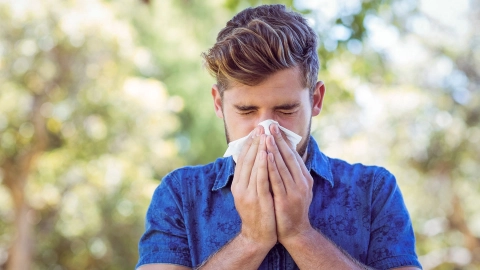Healthy living Climate change and pollen: why allergies are on the increase
Many people suffer from allergic rhinitis due to pollen (“hayfever”). Studies indicate that these allergic respiratory diseases are increasing. Climate change is believed to be one of the causes behind this. This article provides more information about how climate change and pollen allergy are connected.
At a glance
- Allergic respiratory diseases are increasing as the climate changes.
- Plants are in bloom for longer overall as the average temperature rises.
- The longer pollen season and the increase in pollen production are reasons behind the rise in allergic respiratory diseases.
- Pollen-related allergies are caused by an over-reaction of the body’s immune system to plant pollen, which is actually harmless.
- Around 15% of adults in Germany are affected by hayfever.
- Allergic asthma can also be caused by pollen.
Note: The information in this article cannot and should not replace a medical consultation and must not be used for self-diagnosis or treatment.

What is a pollen allergy?
Allergies occur when the body’s immune system over-reacts to substances that are actually harmless such as pollen from flowers circulating in the air.
Typical symptoms of a pollen allergy are sneezing, a runny nose, an urge to cough and red, itching eyes. This is mostly referred to by the non-technical term hayfever. Doctors refer to it as “allergic rhinitis”. In Germany, about 15% of adults have hayfever.
Bronchial asthma, a chronic respiratory disease, can also be triggered by an allergic reaction to plant pollen. This is then referred to as allergic asthma. Unlike hayfever, the symptoms (mainly shortness of breath and wheezing) come in the form of sudden attacks.
How does climate change affect the pollen count?
The effects of climate change have been felt also in Germany for quite some time: they include a rise in the frequency of extreme weather events such as storms or summer heatwaves and the gradual rise in average temperatures. According to the German Meteorological Service DWD, the five hottest years since 1880 did not occur until very recently, but then ran consecutively from 2015 to 2019. Whilst many people are pleased about the long summers, others increasingly suffer from heat-related health problems – particularly cardiovascular disorders.
But how do these changes in the climate in Germany and Europe affect plants, how long they bloom and the spread of pollen? And what might the consequences be for people with pollen-related allergies?
Put simply, the increase in temperatures is also causing a change and shift in the seasons: autumn and winter are becoming milder in terms of their average temperatures. Spring and summer are becoming longer and hotter. Plants are starting to flower earlier and for longer.
Flowering periods are longer overall, increasing periods of high pollen count. Another factor is that species of plants not previously native to Germany are establishing themselves here as the temperatures rise. One of the main allergens (the plants that cause the pollen allergy) is common ragweed (Ambrosia artemisiifolia). This species of ragweed is particularly allergenic. It originated in North America and came to Europe as a result of the globalization in trade.
Another factor in the increased pollen count is believed to be the increase in carbon dioxide (CO2) levels in the atmosphere since carbon dioxide can increase pollen production in many plants. If correct, that would mean that CO2 emissions from households, industry and traffic are not only crucially responsible for global warming; they could also be partly responsible for the rise in pollen-related respiratory disease.
What impact does climate change have on health?
This video shows how some conditions are spreading as a consequence of climate change. Rising temperatures have consequences for people’s health.
This and other videos can also be found on YouTube
Watch nowThe privacy policy indicated there applies.
What are the consequences of climate change for people with a pollen allergy?
The increase in pollen count can exacerbate existing allergies and prolong the acute symptom phases.
Climate change boosts pollen count at a number of levels:
- Many plants are starting to produce pollen earlier.
- The pollen season is becoming longer.
- Many plants are increasing the amount of pollen they produce.
- Plant species, including those such as common ragwort which have a high allergy potential, are establishing themselves as native species.
In addition to the increase in pollen count, climate change has other consequences that could be increasing or exacerbating respiratory diseases:
- More frequent heatwaves and increased pollution due to higher temperatures: these make it more likely that people will get severe forms of chronic respiratory disease.
- Heavier rainfall with flooding: this increases air humidity and could exacerbate chronic respiratory disease.
- More frequent extreme weather events such as storms: there are indications that their abrupt effects on pollen count could also make asthma attacks more likely.
Important: Additional factors such as air pollution through airborne particulates could also make respiratory disease more likely or exacerbate it.
How can you protect yourself against pollen?
There are ways for people with pollen allergies to respond to an increase in the pollen count and mitigate symptoms:
- Outdoor activities should be avoided as far as possible when the airborne pollen count is particularly high.
- It is advisable to keep windows shut when the pollen count is high. It’s better to air rooms when the pollen count is low according to the pollen count forecast.
- The doctor treating the condition can prescribe drug treatment for the allergy and adjust it as required.
- Targeted immunotherapy (hyposensitization) can attenuate or even neutralize the allergic reaction under certain circumstances.
The German Pollen Information Service foundation (PID) provides a number of services that allow you to adjust your activities around the current pollen count. For example, the PID website provides daily and weekly forecasts of the pollen count.
Where can I find more information?
Detailed information about the broad topic of allergies can be found on the allergieinformationsdienst.de website (in German).
- Allergieinformationsdienst. Auswirkungen des Klimawandels. Aufgerufen am 18.01.2021.
- Allergieinformationsdienst. Heuschnupfen. Aufgerufen am 18.01.2021.
- Deutsches Ärzteblatt. Klima und Gesundheit: Klimaresilienz – Weg der Zukunft. Aufgerufen am 18.01.2021.
- D'Amato G, Cecchi L, Annesi-Maesano I. A trans-disciplinary overview of case reports of thunderstorm-related asthma outbreaks and relapse. Eur Respir Rev. 2012 Jun 1;21(124):82-7. doi: 10.1183/09059180.00001712.
- Deutscher Wetterdienst (DWD). Klima und Umwelt. Aufgerufen am 02.06.2021.
- Eguiluz-Gracia I, Mathioudakis AG, Bartel S et al. The need for clean air: The way air pollution and climate change affect allergic rhinitis and asthma. Allergy. 2020 Sep; 75(9): 2170-2184. doi: 10.1111/all.14177.
- Lungeninformationsdienst. Asthma: Symptome, Formen, Entstehung. Aufgerufen am 18.01.2021.
- Stiftung Deutscher Polleninformationsdienst. Das neue Allergen Ambrosia. Aufgerufen am 18.01.2021.
- Umweltbundesamt. Beobachtete und erwartete Klimafolgen. Aufgerufen am 18.01.2021.
- Umweltbundesamt. Trends der Lufttemperatur. Aufgerufen am 18.01.2021.
As at:






